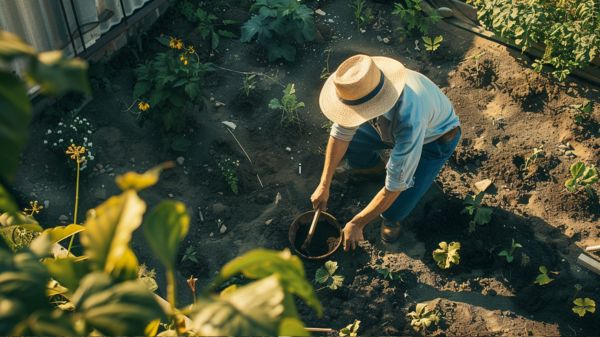As the global emphasis on sustainable living intensifies, the adoption of eco-friendly organic pest control methods for home gardens presents not only an environmental imperative but also a practical gardening solution.
These methods, which include the use of natural predators, organic pesticides, and soil health enhancement, offer a promising alternative to their chemical counterparts. However, the effectiveness of such approaches often hinges on a deeper understanding of ecological balances and localized garden dynamics.
This raises an intriguing question: can these environmentally benign practices provide sufficient and reliable pest control to meet the needs of the avid gardener? This discussion explores the potential and limitations of these methods, inviting a closer look at their practical applications in diverse gardening scenarios.
Understanding Organic Methods
Organic gardening methods prioritize environmental sustainability by eliminating the use of chemical pesticides and fostering a balanced, healthy ecosystem.
Employing organic pest control methods for home gardens not only shields children and pets from harmful chemicals but also protects beneficial insects which are essential for a thriving garden. These insects, such as ladybugs and lacewings, serve as natural predators to common garden pests like aphids and mites, effectively controlling their populations without the need for synthetic interventions.
Integrated pest management (IPM) is a cornerstone of eco-friendly pest control. This strategy combines various organic practices, including the introduction of natural predators and the use of botanical pesticides like neem oil and insecticidal soaps.
These substances offer targeted action against pests while minimizing collateral damage to beneficial species. Furthermore, IPM encourages the use of companion planting to naturally deter pests, thereby reducing the reliance on any form of pesticide.
Soil Health Essentials
Maintaining soil health is essential for ensuring robust plant growth and natural pest resistance in sustainable gardening practices. As we explore deeper into the principles of organic gardening, it’s clear that nurturing the soil is foundational in cultivating a garden that thrives harmoniously with nature.
Key strategies to enhance soil health not only support healthy plants but also fortify them against pests without the need for chemical interventions.
- Compost Addition: Incorporating compost into the garden beds improves soil structure, increases nutrient content, and stimulates the activity of beneficial soil organisms.
- Mulching: Applying organic mulch, such as straw or leaf mold, conserves moisture, suppresses weeds, and gradually enriches the soil as it decomposes.
- Regular Soil Testing: This identifies nutrient deficiencies and pH imbalances, allowing for precise adjustments that optimize soil conditions and strengthen pest resistance.
The journey to restored soil health requires patience and persistence, with a focus on practices that respect and replenish the earth’s natural resources.
Natural Predators and Allies
Harnessing the power of natural predators and allies plays an essential role in sustainable pest management within eco-friendly gardens. By encouraging the presence of beneficial bugs, such as ladybugs and lacewings, gardeners can markedly reduce pest populations naturally. These insects are efficient hunters of aphids and other harmful pests, promoting a healthy garden without the need for chemical interventions.
Bats, another important ally, exemplify the impact of natural predators on pest control. The bats residing under the Congress Avenue Bridge, for instance, consume approximately 10 tons of insects nightly, demonstrating their critical role in maintaining the ecological balance and reducing garden pests.
Augmentation, the introduction of predatory insects or pathogens, further enhances this natural ecosystem. This method not only supports pest management but also bolsters the overall health and resilience of garden environments.
Additionally, diversifying plant species in the garden can attract a wide range of beneficial insects. This not only aids in pest control but also contributes to the biodiversity necessary for a robust ecological system.
Mechanical Control Strategies
Mechanical control strategies offer practical, non-chemical methods to manage pest populations effectively in eco-friendly gardens. These solutions not only help maintain the health of the garden but also support sustainable practices that minimize environmental impact.
Through the application of mechanical devices and simple tools, gardeners can address pest issues without resorting to chemical interventions, thereby promoting a liberated and harmonious relationship between human activity and nature.
Key components of mechanical pest control include:
- Insect Vacuums: These devices suck up insects gently yet effectively, providing an immediate solution to pest infestations without harming the plants or using toxic substances.
- High-Pressure Water Sprays: Utilizing a forceful stream of water to knock pests off plants, this method allows for natural pest control while preserving the integrity of both plants and their surrounding environment.
- Sticky Traps: Strategically placed, these traps capture flying and crawling insects, considerably reducing pest populations without spreading chemicals.
These strategies guarantee a sustainable approach to gardening by prioritizing ecological balance and effective pest management.
Chemical-Free Solutions
As we explore chemical-free solutions in eco-friendly pest control, it is essential to contemplate the efficacy and environmental impact of various alternatives.
Homemade insecticidal soaps provide a safe and cost-effective method for controlling soft-bodied pests, minimizing damage to plants and beneficial insects.
Additionally, the utilization of botanical insecticides and diatomaceous earth offers potent pest management options that align with sustainable agricultural practices.
Homemade Insecticidal Soaps
Homemade insecticidal soaps, utilizing simple ingredients like diluted liquid castile soap, offer an effective and environmentally sustainable solution for controlling soft-bodied pests such as aphids and spider mites.
These organic concoctions are pivotal in the fight against garden pests, serving as a primary defense without the use of harmful chemicals. Insecticidal soap, particularly homemade varieties, is a cornerstone in organic gardening, enabling gardeners to remove pests while maintaining ecological balance.
Consider the following benefits and guidelines:
- Efficacy: Homemade insecticidal soaps are highly effective on pests like aphids, which can devastate plants. They act by breaking down the insect’s outer layer, leading to dehydration.
- Safety: Unlike synthetic pesticides, these soaps are safe for the environment, posing minimal risk to pollinators and other beneficial insects when used correctly.
- Cost-Effective: Preparing your insecticidal soap solution is considerably cheaper than purchasing commercial products.
Botanical Insecticide Benefits
Botanical insecticides, derived from natural plant sources, present a viable, low-toxicity alternative for managing garden pests without the adverse effects associated with synthetic chemicals. These botanical solutions, including renowned agents like neem oil and pyrethrum, offer organic pest control while safeguarding beneficial insects essential for a balanced ecosystem.
Neem oil, for instance, acts as a dual-function tool in the gardener’s arsenal, serving both as a repellent and an appetite suppressant for many common pests. Conversely, pyrethrum targets the nervous system of insects more directly, yet does so with a specificity that minimizes collateral damage to non-target species.
The inherently lower toxicity of botanical insecticides is a significant advantage, ensuring that these substances break down more rapidly in the environment. This rapid degradation reduces the risk of long-term ecological damage, a common concern with synthetic pesticides.
Additionally, the integration of botanical insecticides within broader organic pest control strategies enhances their efficacy and contributes to a more sustainable gardening practice. By understanding and respecting the life cycles of pests and beneficial insects alike, gardeners can implement these botanical solutions effectively, promoting a healthier, more resilient garden ecosystem.
Diatomaceous Earth Usage
Diatomaceous earth, a naturally occurring, powdery sediment, offers a chemical-free solution for controlling hard-shelled pests in organic gardening environments.
As a substance revered for its minimal impact on beneficial insects and utmost safety around children and pets, diatomaceous earth stands out as an exemplary method of pest control. This non-toxic approach aligns with the principles of sustainable living and organic gardening, ensuring that the ecosystem thrives without the introduction of harmful chemicals.
Key benefits and usage tips include:
- Safety and Effectiveness: Diatomaceous earth is lethal to unwanted pests like aphids and beetles but harmless to beneficial insects when applied carefully, preserving the ecological balance.
- Ease of Application: It can be easily sprinkled around the base of plants or along the perimeter of garden beds where pests are prevalent.
- Importance for Reapplication: Regular monitoring and reapplication after rain or irrigation are essential to maintain its effectiveness.
Utilizing diatomaceous earth not only liberates your garden from reliance on synthetic chemicals but also fosters a healthier, more sustainable environment for plants and pollinators alike.
Diverse Planting Benefits
Diverse planting strategies, such as the integration of specific herbs and companion species, play an essential role in enhancing pollinator activity while concurrently reducing pest incidence in gardens.
By introducing a variety of plants that naturally repel pests and attract beneficial insects, gardeners can establish a more resilient ecosystem.
This approach not only minimizes the reliance on chemical pest control but also supports sustainable gardening practices by promoting biodiversity and ecological balance.
Enhancing Pollinator Attraction
Implementing a variety of flowering plants in a garden considerably enhances the attraction of pollinators, supporting a marked increase in biodiversity and ecosystem health. By diversifying the types of flowers and plants, gardens become not just visually appealing but also a stronghold for ecological balance. This diversification invites a range of pollinator species, which in turn helps in maintaining the health and productivity of the garden.
Native Plants: Incorporating native species acts as a magnet for local pollinators by providing familiar and essential resources, thereby fostering a thriving pollinator ecosystem.
Medicinal and Edible Flowers: Flowers like chamomile and nasturtium not only attract beneficial insects important for pest control but also offer additional herbal and culinary benefits, promoting a multifunctional garden space.
Varied Blooming Periods: Strategic planting to guarantee staggered blooming times across seasons secures a consistent food supply for pollinators, which is crucial for their sustenance and the pollination continuity.
Companion Planting: Utilizing companion plants among the vegetable and fruit beds enhances the mutual benefits of attracting pollinator species while naturally deterring pests through increased plant diversity.
These strategies collectively enhance pollinator presence, which is essential for achieving sustainable garden productivity and ecological health.
Reducing Pest Incidence
Building on the enhancement of pollinator attraction, the adoption of diverse planting methods also plays a significant role in reducing pest incidence in gardens. Diverse planting not only enriches the ecological fabric of a garden but also invites a variety of beneficial insects that act as natural pest control agents. By integrating companion planting strategies, gardeners can effectively utilize nature’s own mechanisms to disrupt and manage pest populations.
For instance, pairing marigolds with vegetables can deter harmful nematodes and aphids, thereby safeguarding plant health and reducing the need for chemical pesticides. This method leverages the natural properties of marigolds to emit compounds that are unpalatable to many pests. Additionally, a varied plant selection helps in breaking the continuous crop cycles that many pests thrive on, consequently reducing their chances to establish and proliferate.
Here is a succinct overview of how diverse planting contributes to pest management:
| Strategy | Benefit |
|---|---|
| Companion Planting | Deters specific pests, breaks pest cycles |
| Predator Attraction | Encourages beneficial insects |
| Crop Diversity | Disrupts pest life cycles |
Implementing these strategies not only reduces pest incidence but also enhances garden sustainability, promoting a healthier, more resilient ecosystem.
Routine Garden Maintenance
Routine garden maintenance is essential for early detection and management of pest issues, ensuring the health and longevity of your plants. By integrating specific practices into your daily gardening routine, you can sustainably manage pests and enhance your garden’s resilience.
The following pillars of routine garden maintenance are critical:
- Monitoring Plants: Regularly inspect plants for signs of stress or pest activity. This proactive surveillance enables early intervention, thereby minimizing potential damage and discouraging further infestation.
- Pruning Damaged Leaves: Remove leaves that are damaged or diseased to prevent pests from taking refuge or breeding. This not only reduces pest habitats but also encourages healthier growth in plants.
- Cleanliness in the Garden: Keep the garden free from debris, fallen fruits, and weeds. A clean garden minimizes the spaces where pests can breed and hide, thereby reducing their population.
Adhering to these methods not only fosters a thriving garden but also aligns with sustainable, eco-friendly pest control strategies. These practices empower gardeners to protect their sanctuaries naturally, promoting both plant health and environmental balance.
Proactive Pest Prevention
Beyond daily maintenance, proactive pest prevention involves strategic actions that fortify your garden’s defenses against potential infestations. Confirming that your plants are healthy through regular monitoring and appropriate care is pivotal, as healthy plants inherently resist pests more effectively. By incorporating companion planting, the natural properties of certain pest-repellent herbs and flowers can be harnessed to protect your garden without the need for chemical interventions.
Crop rotation disrupts the life cycles of pests, preventing them from becoming established. By alternating the types of crops planted in specific areas of your garden each year, you decrease the likelihood of pests adapting and thriving. Similarly, maintaining cleanliness by removing debris and fallen fruits eliminates breeding grounds for pests, further safeguarding your garden.
Encouraging beneficial insects through diverse plantings not only enhances pollination but also improves integrated pest control by inviting natural predators into the space. This holistic approach confirms a balanced ecosystem where beneficial insects thrive, naturally managing pest populations.
Here is a concise table summarizing proactive strategies:
| Strategy | Benefit |
|---|---|
| Healthy Plant Care | Builds resilience against pest infestations |
| Companion Planting | Uses natural repellents to deter pests |
| Crop Rotation | Disrupts pest life cycles |
| Cleanliness | Removes potential pest habitats |
| Beneficial Insects | Promotes natural pest management |
Implementing these strategies collectively fosters a robust, sustainable approach to garden pest control.
Learning and Community Resources
Engaging with community resources and educational platforms enhances gardeners’ abilities to implement eco-friendly pest control effectively. By tapping into a wealth of knowledge and collective experience, gardeners can learn more sophisticated, sustainable methods that not only protect their plants but also contribute positively to the environment. The emphasis on learning and applying organic gardening principles underscores a commitment to both personal and ecological health.
Key resources to evaluate include:
- Gardening Forums and Online Communities: These platforms facilitate the exchange of eco-friendly pest management strategies and foster a sense of solidarity among environmentally conscious gardeners.
- Structured Learning Programs: Institutions like Salad Garden School and Kitchen Garden Academy offer courses specifically tailored to teach sustainable pest control and organic gardening techniques.
- Local Workshops and Events: Participating in these gatherings can enhance practical knowledge and provide networking opportunities with like-minded individuals.
These learning and community support systems are instrumental in cultivating a garden space that thrives on the principles of sustainability and responsible stewardship. By embracing these resources, gardeners empower themselves and their communities to foster environments where nature and human innovation flourish in harmony.
Conclusion
In summary, eco-friendly pest control in home gardens exemplifies a sustainable approach that balances effective pest management with environmental stewardship.
By integrating organic methods, emphasizing soil health, utilizing natural predators, and employing mechanical and chemical-free strategies, gardeners can foster biodiversity and promote ecosystem resilience.
This holistic practice not only enhances garden health but also contributes to long-term sustainability, demonstrating a viable alternative to conventional chemical-dependent pest control methods in agriculture.




